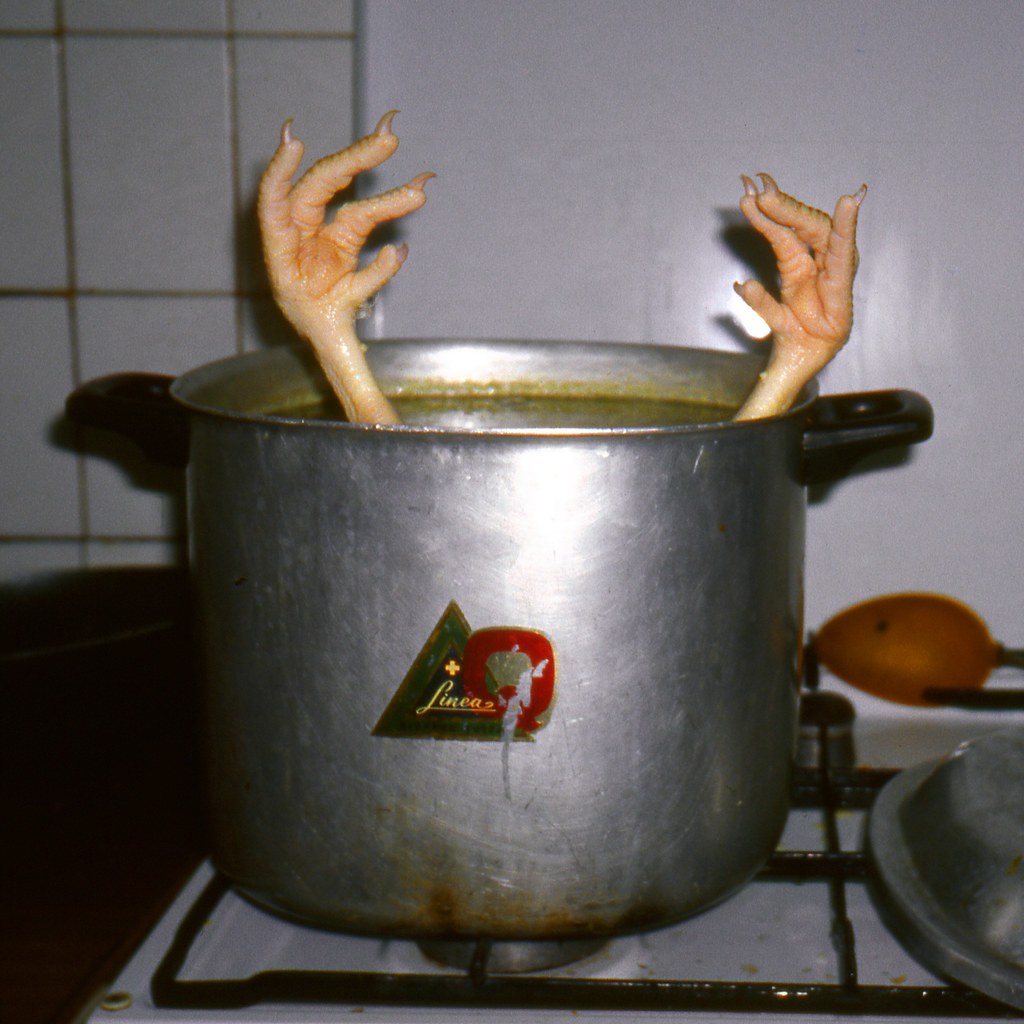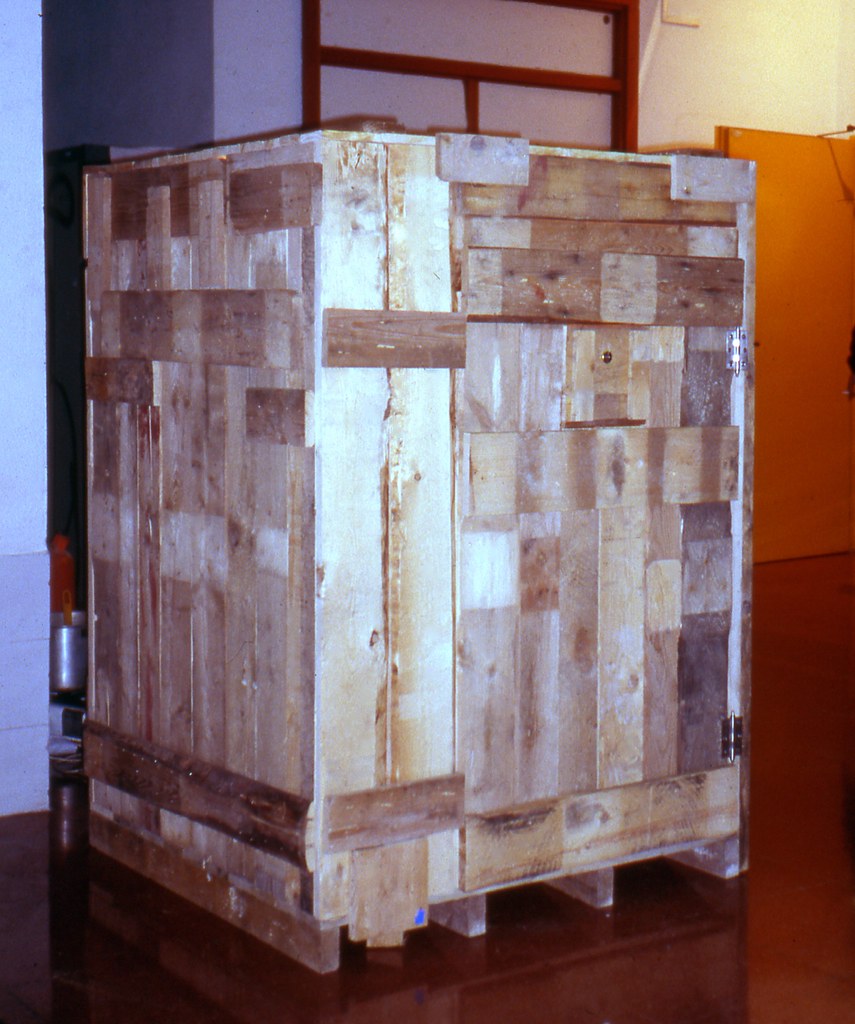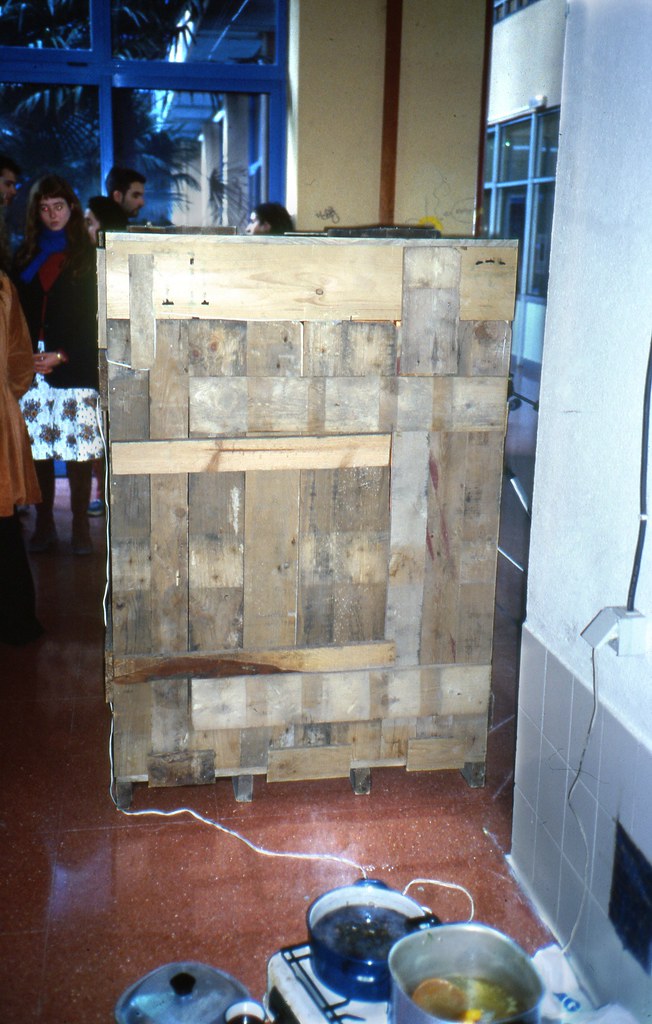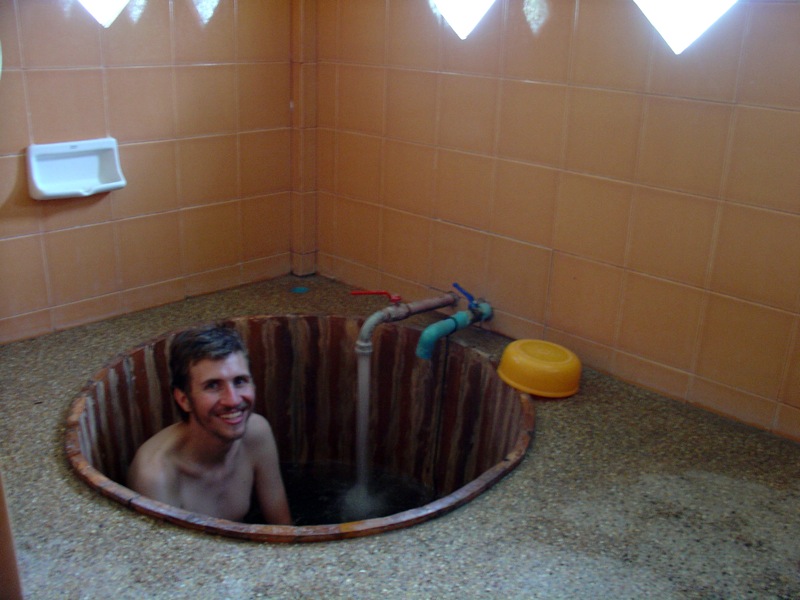11 May 2009
05 March 2007
Un Lugar Donde Comer Sopa
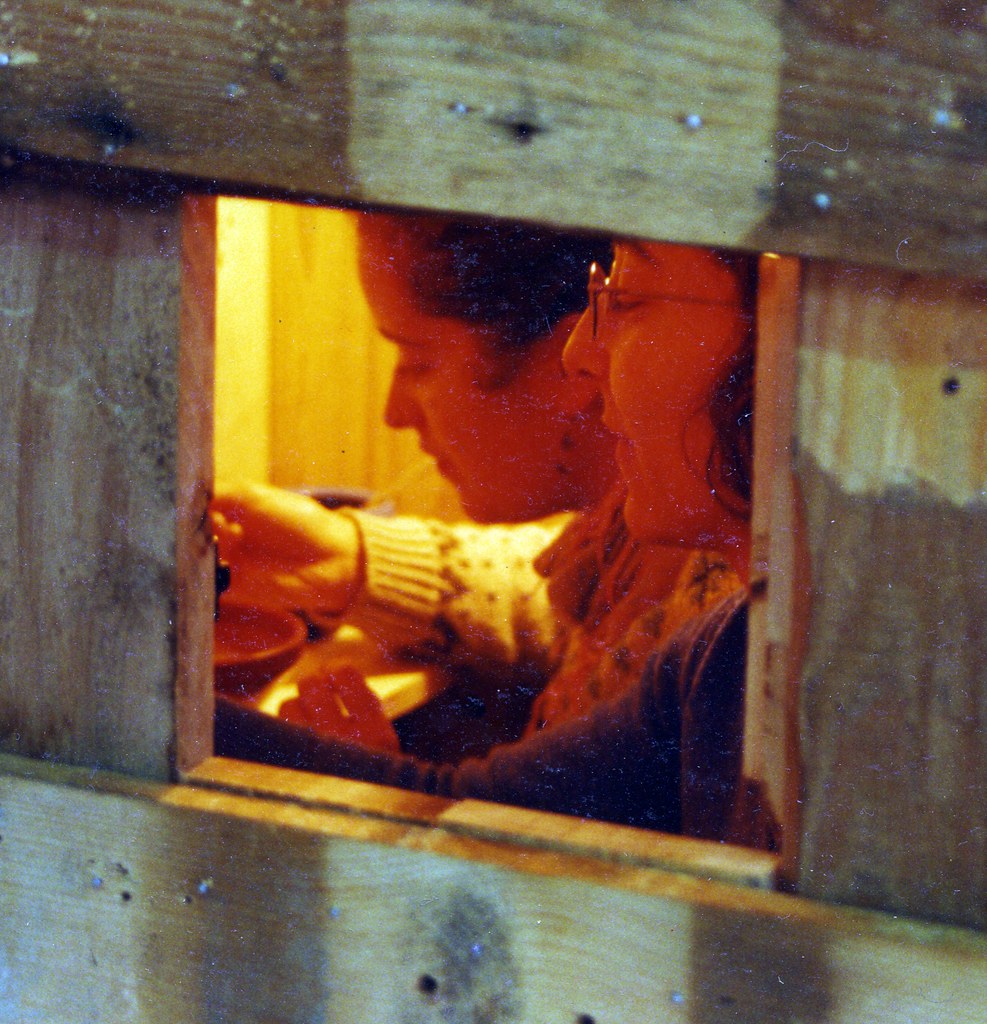
Over on our food blog, Quotidian Efficacy, I posted a chicken soup recipe, the direct descendant of a recipe I used in an installation back when I lived in Valencia. Entitled Un Lugar Donde Comer Sopa, and unofficially dubbed "la caja de sopa" or "the soup box," it consisted of a wooden box, one meter square at the base and about 150 cm tall. The wood for the box was salvaged from old pallets and construction sites. The exterior was left aged, embedded with nails, plaster, concrete, and paint. The interior was sanded clean, and all the nails used in the assembly of the walls were nailed from the inside out. On one side was a door with a small window and a peephole, looking out. The door and window could be locked from the inside. There was an incandescent light bulb on the wall opposite the door, and a pair of shelves on the wall to the left of the door. One shelf ran along the top of the box, and contained about six books: Plantas medicinales de la Comunidad Valenciana, La poética del espacio by Gaston Bachelard, Si una noche de invierno un viajero by Italo Calvino, El placer del texto by Roland Barthes, and two or three others I can't recall. All over the interior of the box, hidden in nooks and crannies, were quotes from the books, and songs by Os Mutantes, written in English, Spanish and Portuguese. The other shelf was placed just above the knees, so that people could set a bowl of soup and a cup of tea there. The tea, more properly called an infusion, was designed to make people sleepy (the recipe is also available at Quotidian Efficacy). People entered the box one or two at a time, and I served them soup and tea, allowing them ten or fifteen minutes to sit, and eat, and drink, and read. One girl turned the lights off and just sat in the dark for fifteen minutes.
While looking through my archives to find the sketches below I came across this quote from The Poetics of Space, which perfectly describes my goal for the piece. I'll attempt to translate as best I can:
A veces un mueble amorosamente labrado tiene perspectivas interiores modificadas sin cesar por el ensueño, se abre el mueble y se descubre una morada. Una casa que está oculta en un cofrecillo.
Sometimes a lovingly made piece of furniture has interior perspectives unceasingly modified by reverie--upon opening it one discovers a habitation. A house that has been hidden in a tiny coffer.
The soup box had a number of inspirations, primary among them would be The Poetics of Space, but I would also have to include things like Dr. Who's Tardis, a drab box with a nearly infinite interior. It also spawned a number of progeny--among them, my Reading Cell, and a mini office my Portugese professor cobbled together (though perhaps only in his head) under his stairs.
After completing the piece and feeding everyone soup I planned on dismantling it and giving the wood away, but some friends conspired to save it. To this day, in theory at least, the box is in storage in a workshop in an old house in the tiny town of Infante.
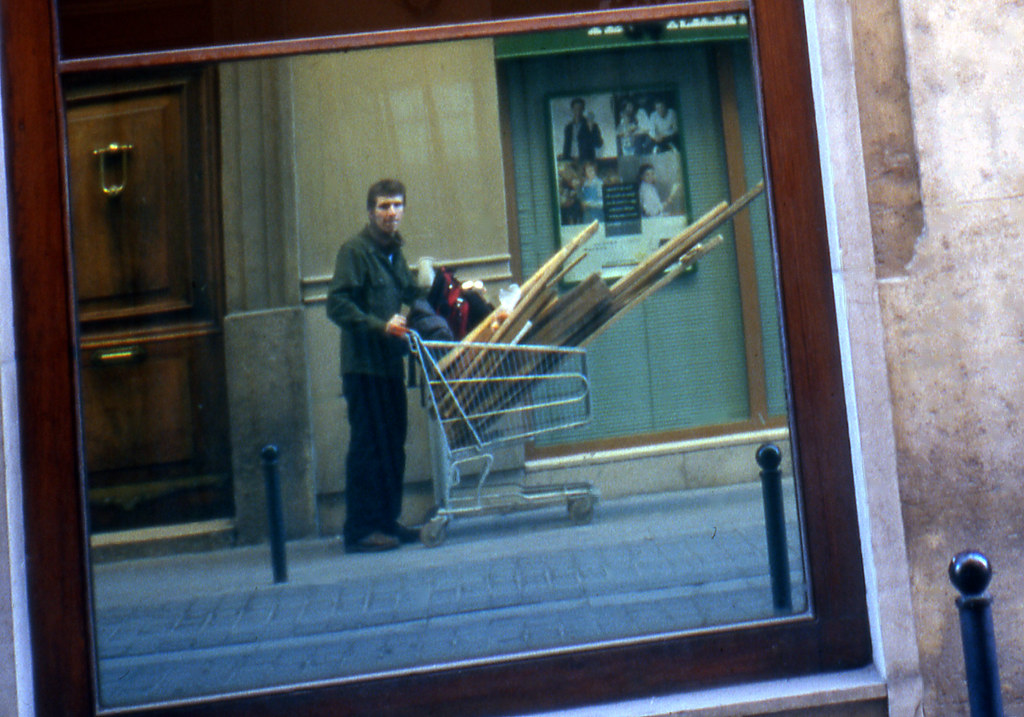 Moving wood. I would collect wood at construction sites downtown, and then push it to the Polytechnic in a shopping cart. Later on I found a bunch of pallets at school, and was spared some unnecessary labor.
Moving wood. I would collect wood at construction sites downtown, and then push it to the Polytechnic in a shopping cart. Later on I found a bunch of pallets at school, and was spared some unnecessary labor.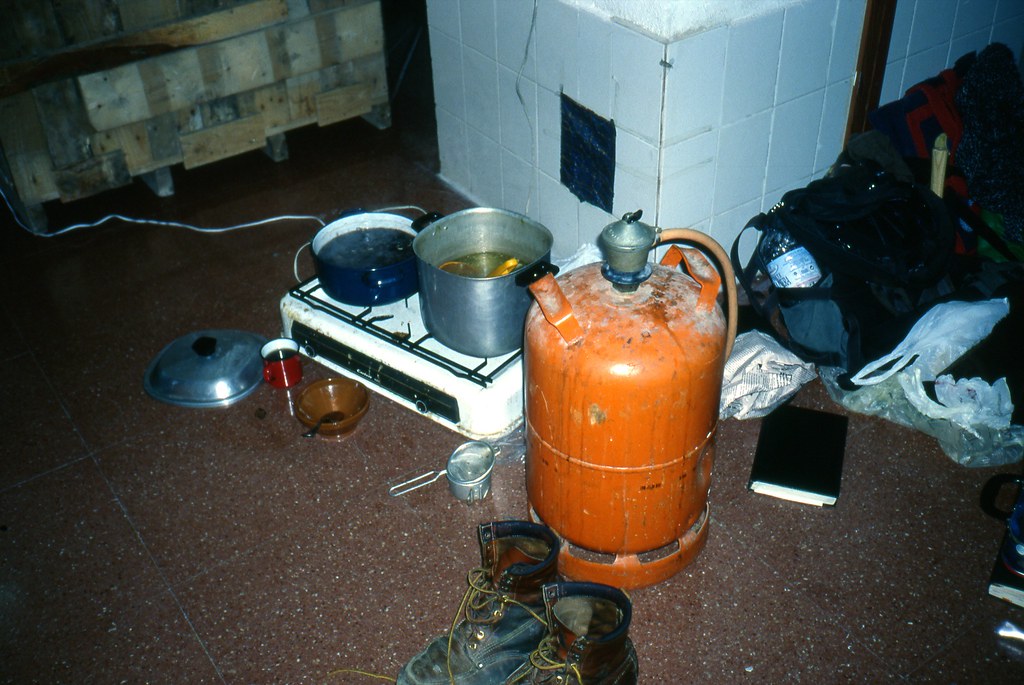 Makeshift kitchen. I made everyone take off their shoes, hence my boots in the foreground, but the concept proved decidedly foreign to the Spaniards.
Makeshift kitchen. I made everyone take off their shoes, hence my boots in the foreground, but the concept proved decidedly foreign to the Spaniards.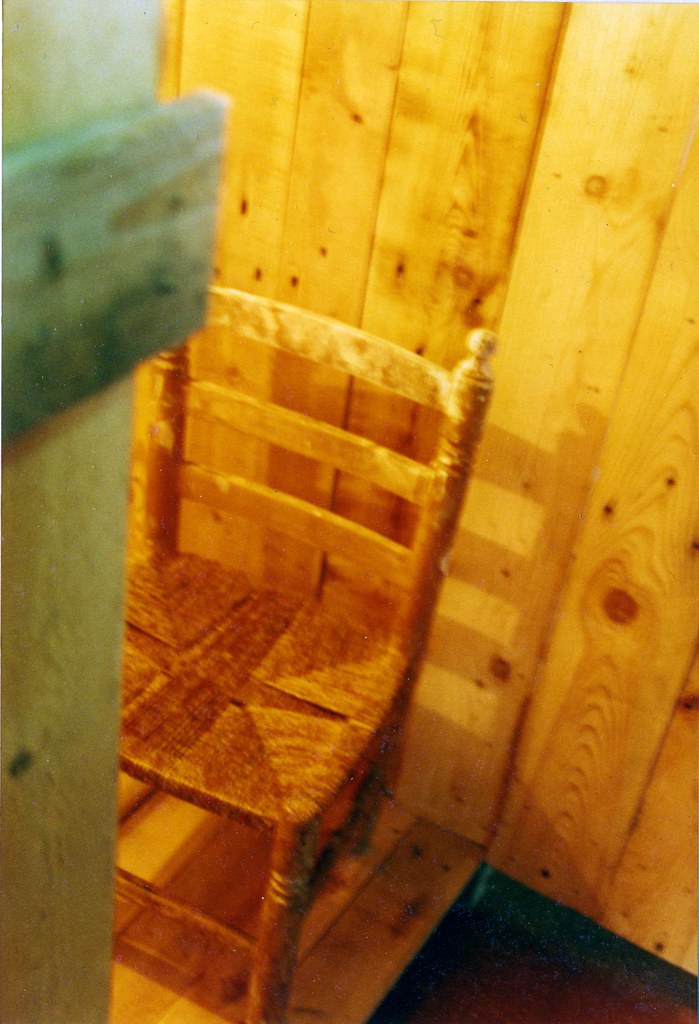 This photo, the one up top, and those that follow were all taken by Elena, a gal in my sculpture class. I found this little chair in the trash (Valencia has the greatest trash, you could furnish a flat with it in less than a month), and refinished the bottom.
This photo, the one up top, and those that follow were all taken by Elena, a gal in my sculpture class. I found this little chair in the trash (Valencia has the greatest trash, you could furnish a flat with it in less than a month), and refinished the bottom.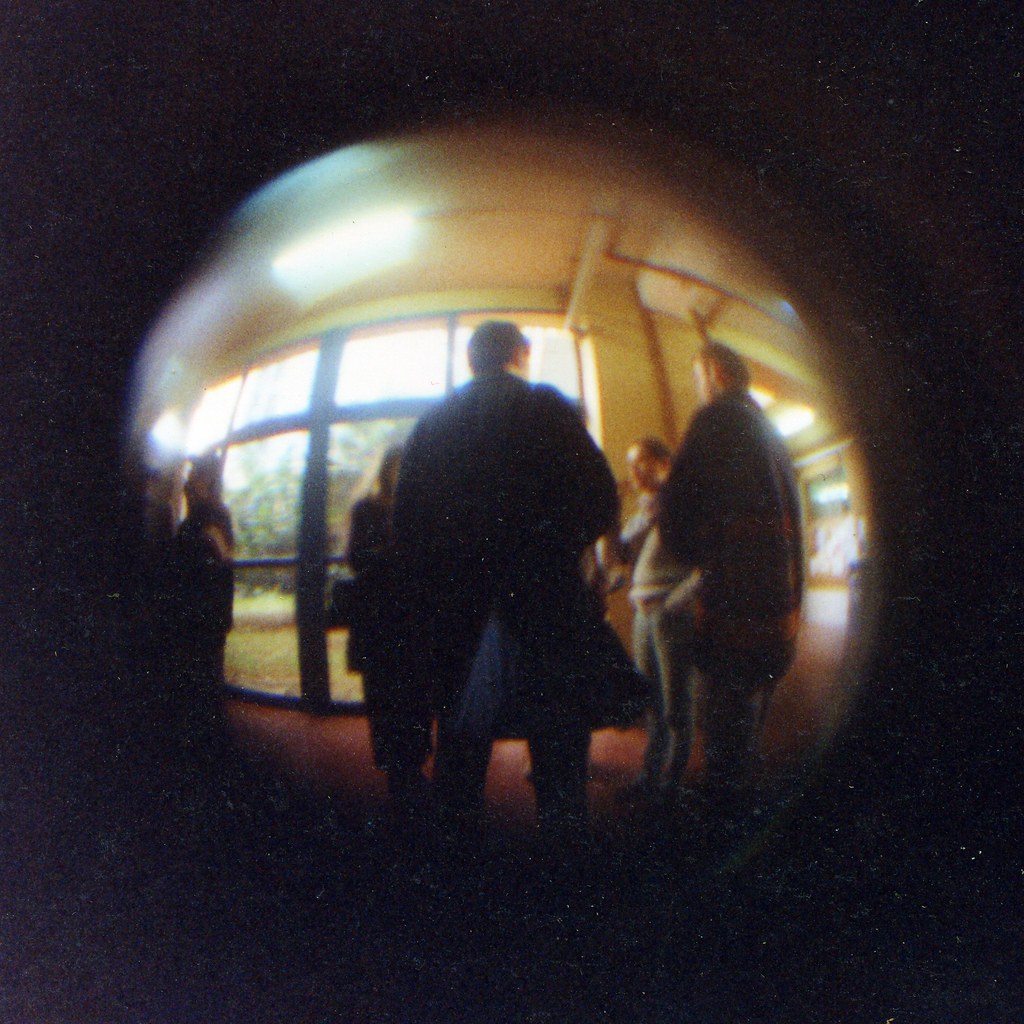
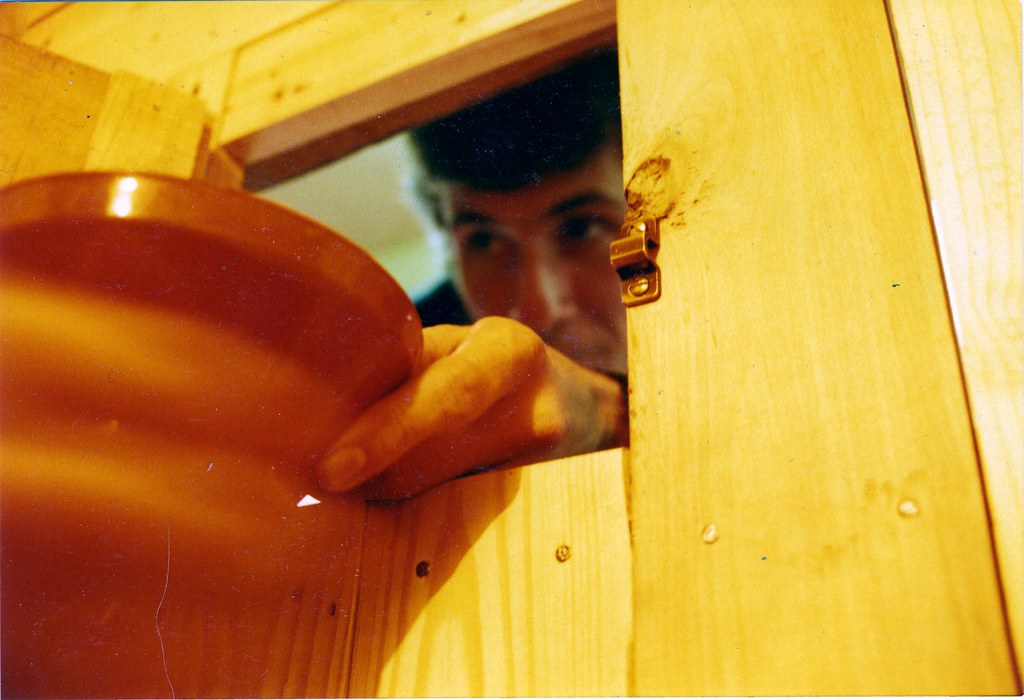
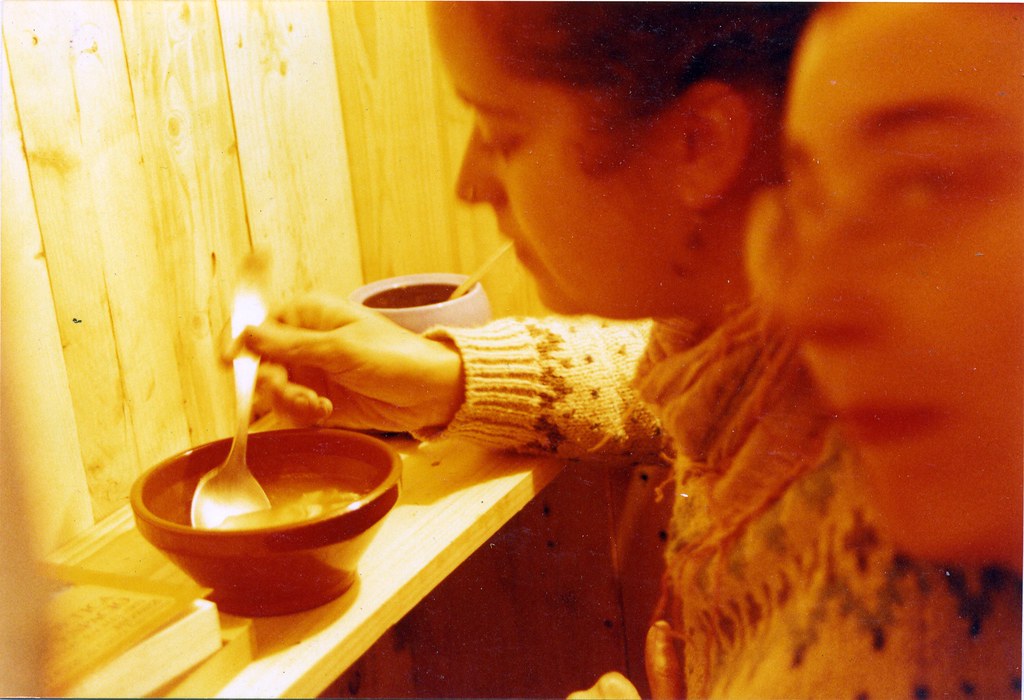

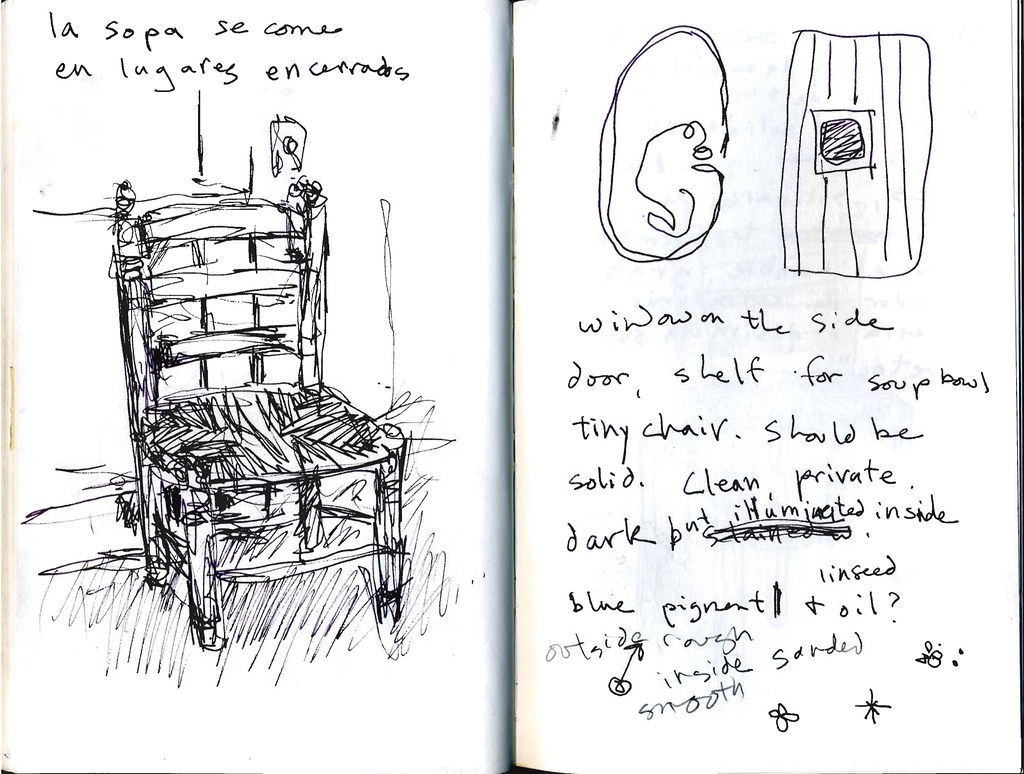
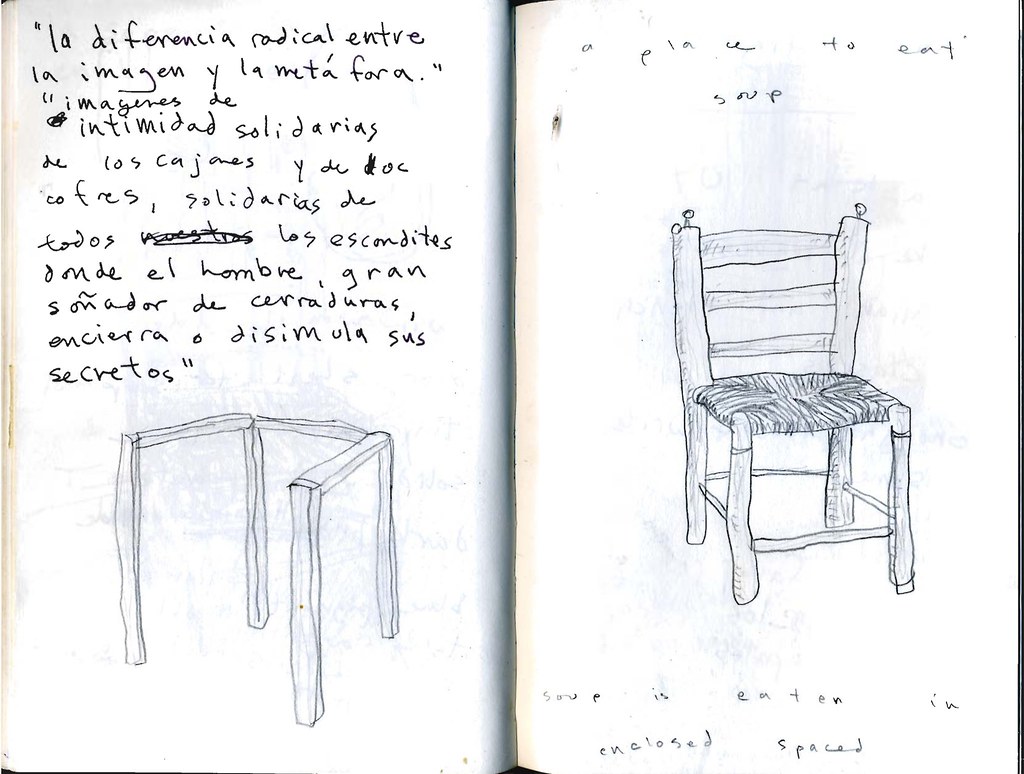
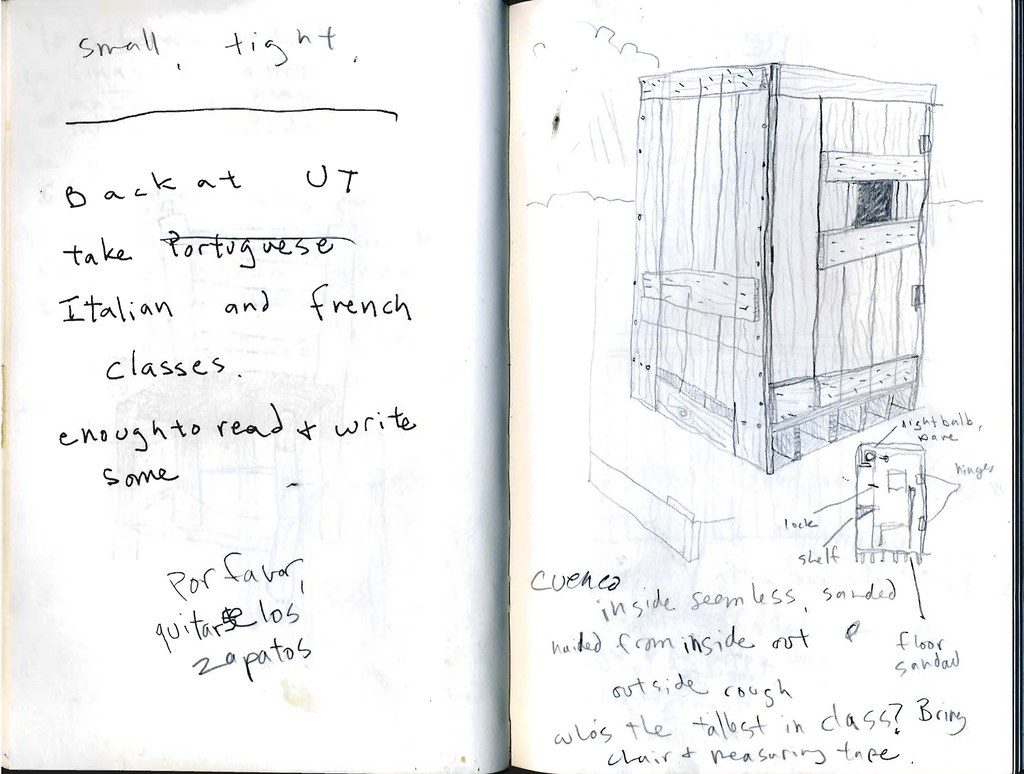
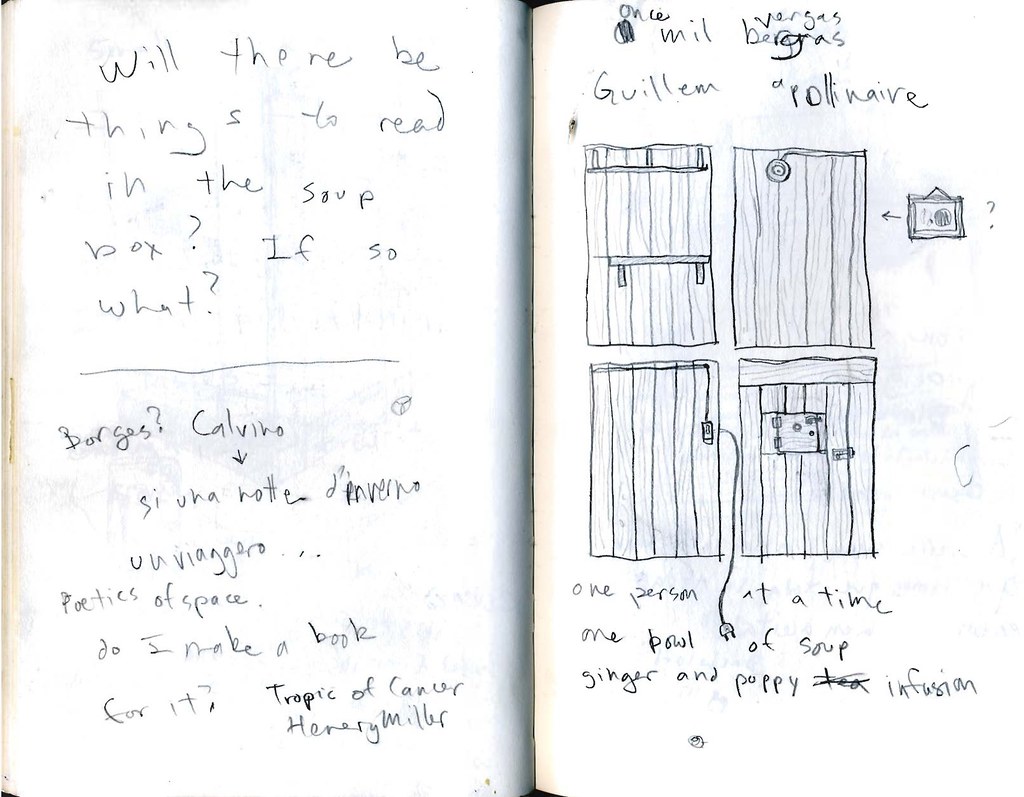

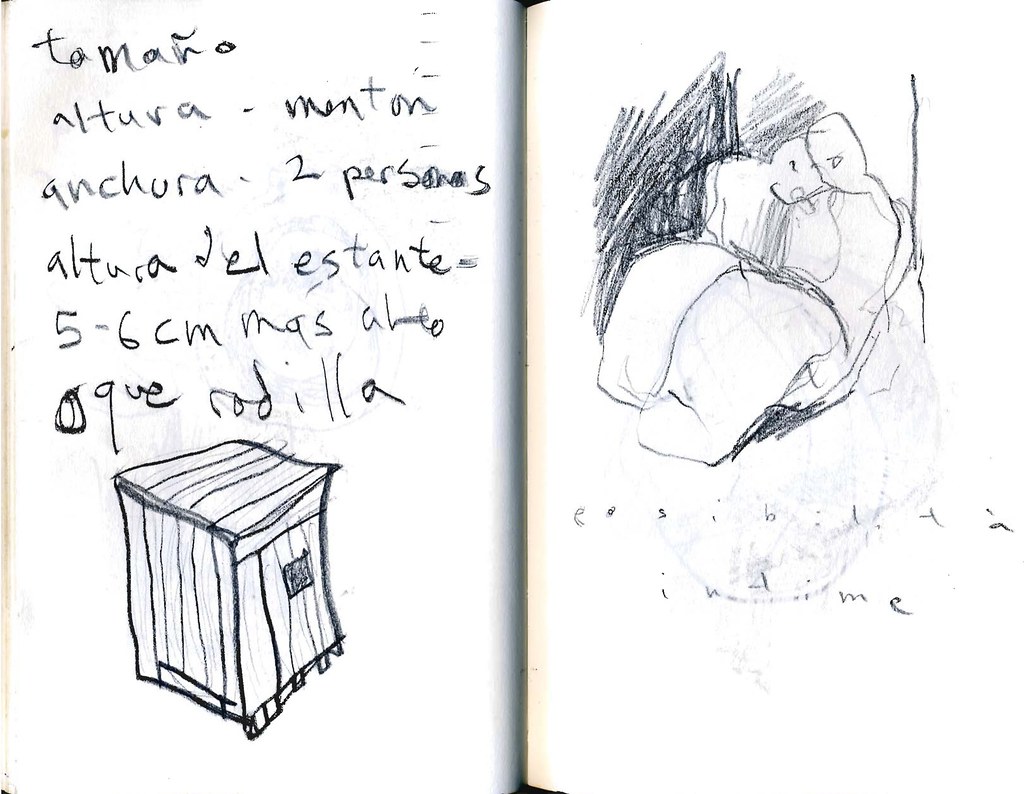
Posted by
Dane
at
4:15 AM
0
comments
![]()
Labels: art, food, installation, Spain
28 February 2007
Quotidian Efficacy

I started a new blog today--Quotidian Efficacy, named after two of our favorite davehickeyan mannerisms. It's really just an online recipe book for ourselves in blog format, but it might be of interest/use to other people, and the labeling should serve as a decent index. So far I've posted a yogurt recipe. Happy cooking.
Posted by
Dane
at
11:43 AM
3
comments
![]()
25 February 2007
Solar Dehydrator

We've been taking advantage of the hot/dry season, and making sun-dried tomatoes on the balcony. As an experiment we also made a passive-solar convection dehydrator out of a couple of old boxes. Unfortunately we don't have an ideal place to put it, and it only gets direct sun for about five hours a day. Our first trial batch of bananas is up on the top balcony, waiting for daylight. We'll let you know how it works.

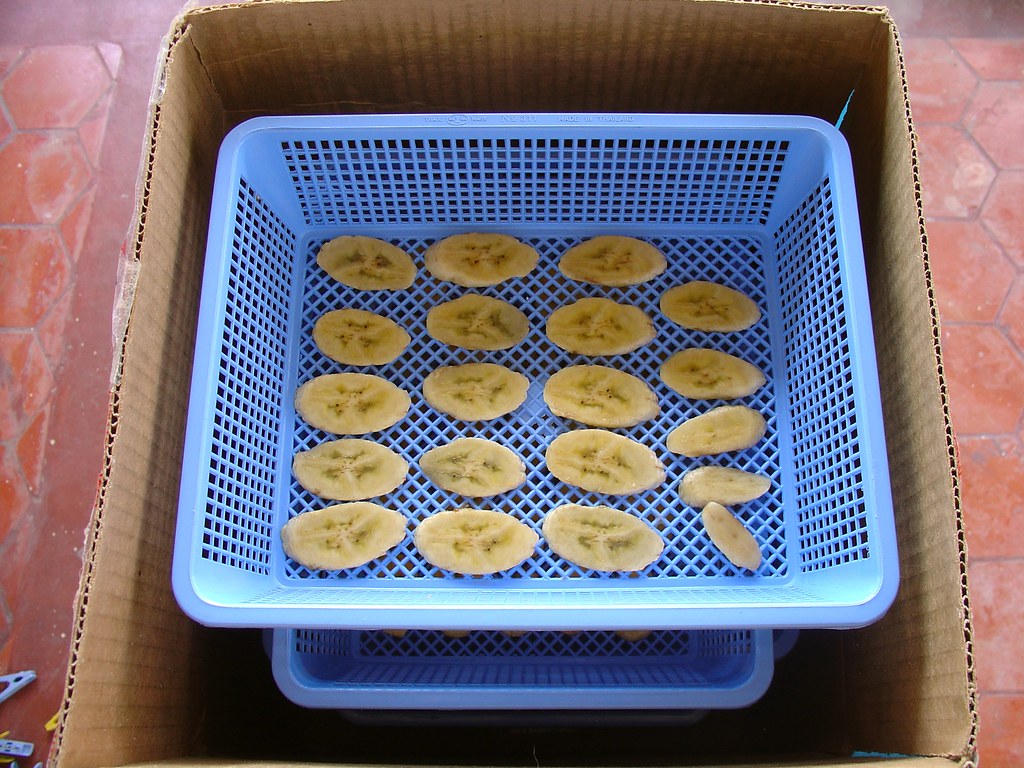

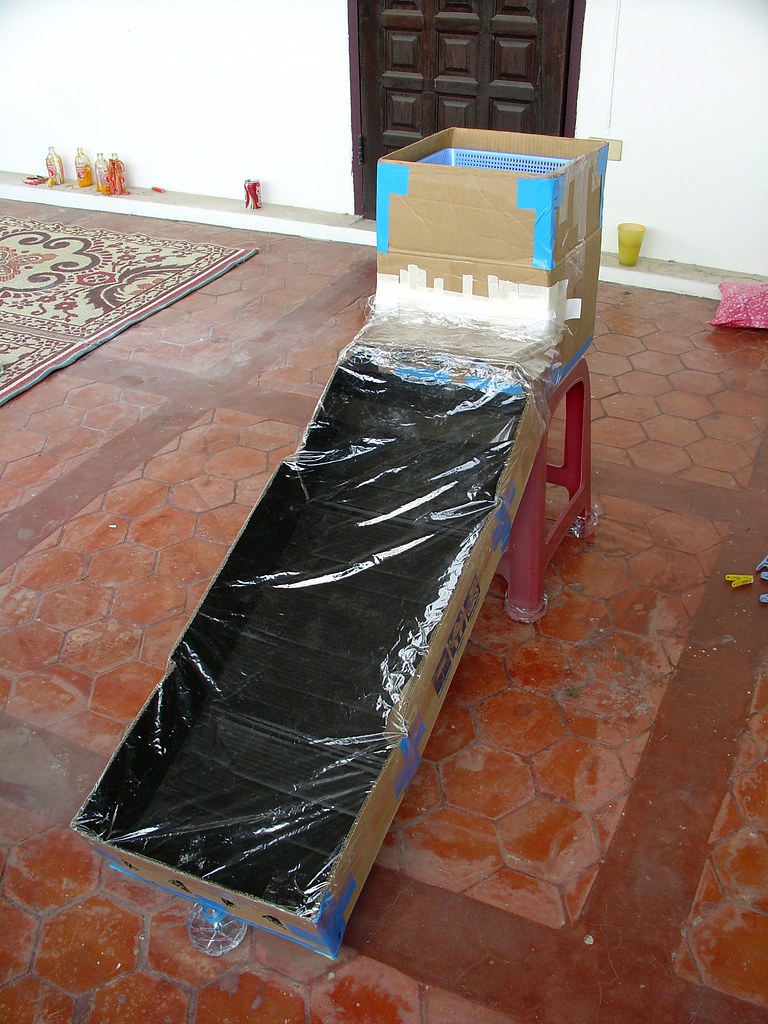
Posted by
Dane
at
2:50 AM
4
comments
![]()
02 February 2007
San Kamphaeng Hot Springs
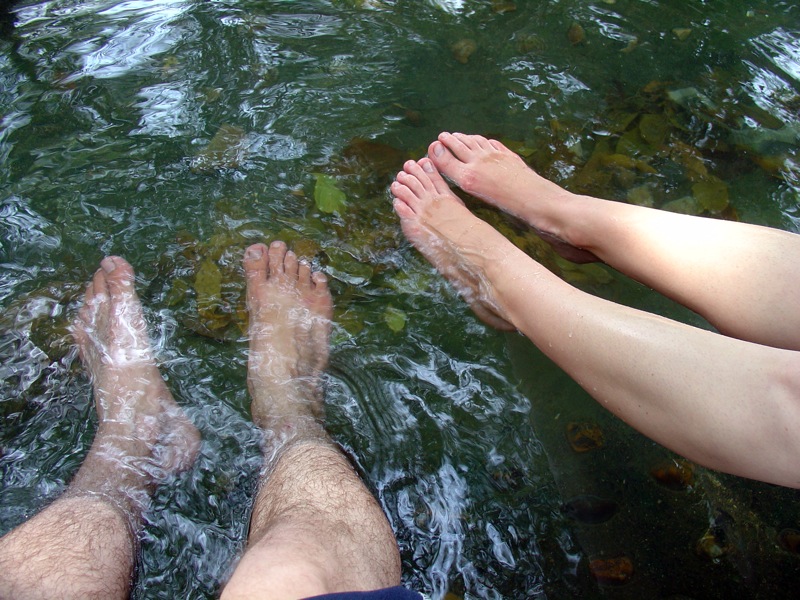
On Wednesday after work we drove east out of town towards San Kampaeng, and then north from there to Thailand's egg strewn answer to Yellowstone. There is a small thermally active valley there full of sulfur rich hot springs. Any natural features that once existed have been destroyed, and the 105˚ C water gets piped around to little basins which people use to boil eggs (the egg boiling is such a popular gimmick with the Thai that they have a fountain featuring giant chicken and quail eggs), and two fake geysers. The cooler water has been channelized, so you can soak your feet while you eat your eggs. They also have private cabins with Japanese style baths where you can take a mineral soak for 200 ฿ an hour. After the bath Jami told me I looked younger. When I asked how much younger she said, "Younger than when we met." That was six years ago, so the water really worked some magic on me. I think it's because my back didn't hurt (I've gotten to where I hardly notice the near constant pain). May be I should see a chiropractor.
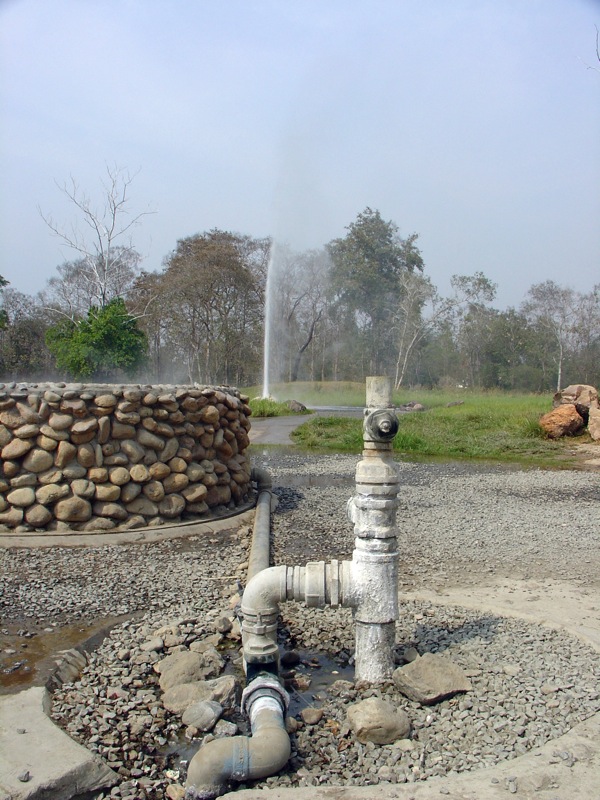 At Yellowstone we always joke about looking for the pipes. At San Kamphaeng they're out for all to see.
At Yellowstone we always joke about looking for the pipes. At San Kamphaeng they're out for all to see.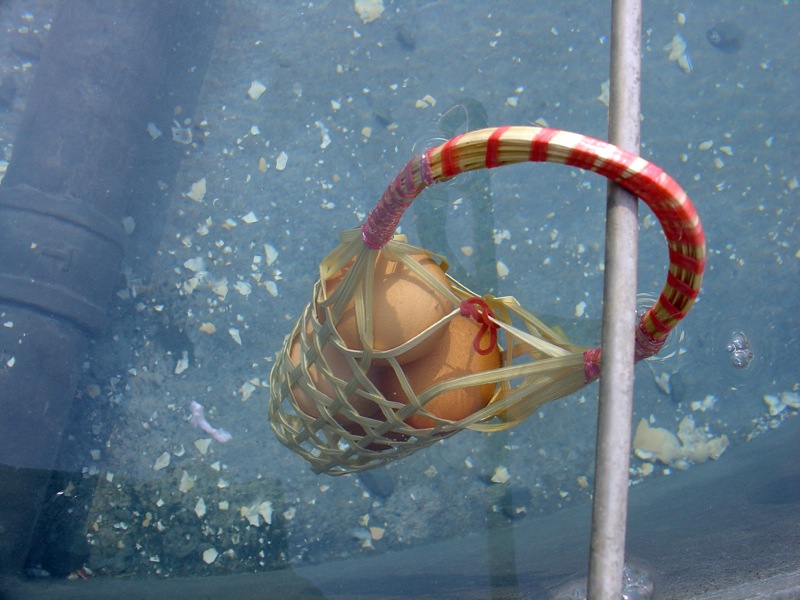
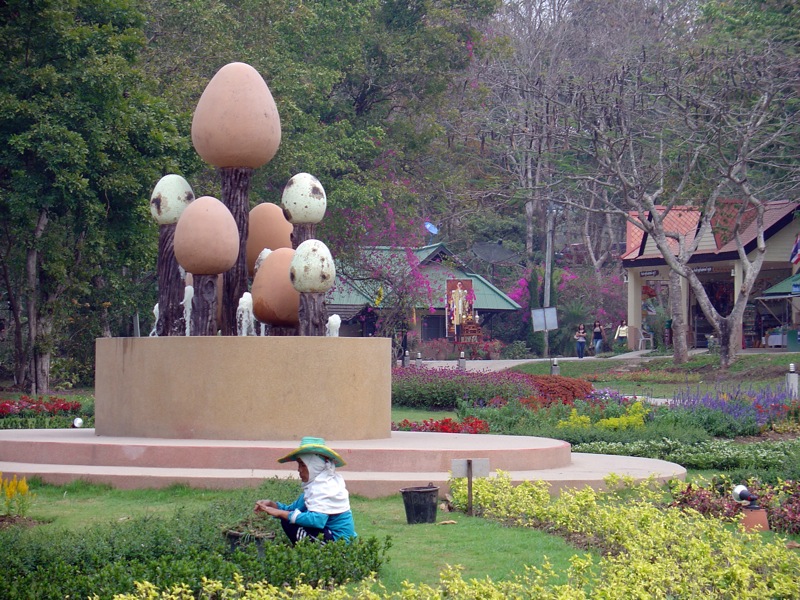
Posted by
Dane
at
3:45 AM
3
comments
![]()
Labels: Chiang Mai, food, Thailand
02 December 2006
Escherichia coli
Would you rather:
a. suffer from severely dehydrating diarrhea?
b. vomit every two hours?
c. spend ten hours on a bus making an obligatory visa run?
d. all of the above?
Posted by
Dane
at
8:29 PM
6
comments
![]()
09 November 2006
16 October 2006
"Believe" Lanna Style: Or How Does a Horse Eat a Japanese Ceramicist: Or How to Eat a Bug Sober
Our design workshop began two weeks ago Monday, and ended last Saturday. It was hosted by the Chiang Mai University Faculty of Fine Art Craft and Design Service Center. The real name of the workshop ("Believe" Lanna Style International Workshop) was almost as long as the organization hosting it. Monday morning began with two excellent presentations by Professor Vithi Panitchapun covering Northern Thailand's history, culture, and visual culture (I have both power points saved as PDFs, they really are great, but it might not be that nice of me to upload them without permission, but if anyone is interested I could send them a copy). After Vithi's presentations he took us around Chiang Mai and Lampang for two days. It reminded us a bit of being in Italy, the tour bus rolling through the green hills, but tropical.
I found out about the workshop the night before it began thanks to our housemate AS. Apparently two designers had canceled, AS had been invited by a friend to participate, but decided that producing two prototypes in two weeks might not be his cup of tea. So he passed the buck to me (Jami and I both thank him for that), and I agreed to do it, not really knowing what I'd be getting into. Jami came with me the first day, just for the lecture, and since they were still one person shy of a quorum they begged her to join.
Day One:
 We visited many, many wats in Chiang Mai that first day. This was a small one in a larger compound near the center of town.
We visited many, many wats in Chiang Mai that first day. This was a small one in a larger compound near the center of town. There are many different "brands" of singha (temple dogs) according to Vithi. This nifty feller with the pageboy hairdo is pretty unique.
There are many different "brands" of singha (temple dogs) according to Vithi. This nifty feller with the pageboy hairdo is pretty unique. This crackly glass is a unique, lead-backed type. It can actually be cut with scissors. The art of making it has been lost, however. So people strip it from the old wats, sell it by the kilo, and replace it with crummy colored mirror.
This crackly glass is a unique, lead-backed type. It can actually be cut with scissors. The art of making it has been lost, however. So people strip it from the old wats, sell it by the kilo, and replace it with crummy colored mirror.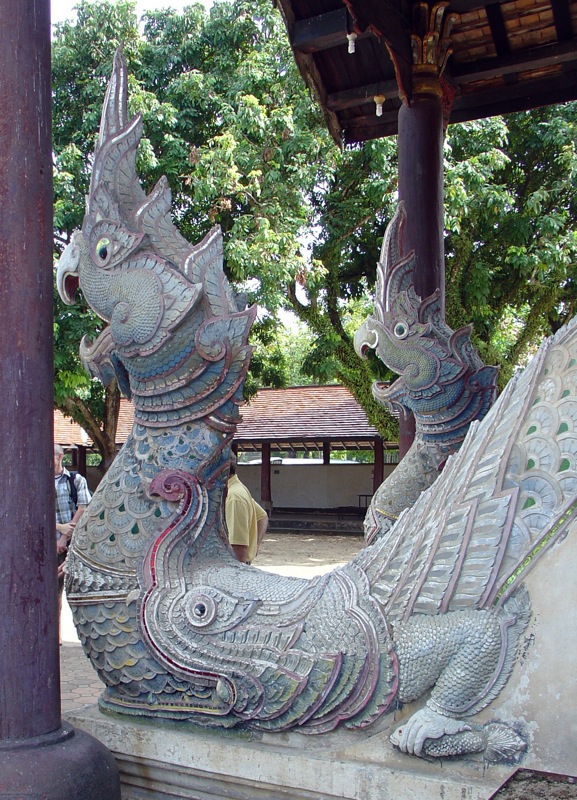 This water-serpent naga with a mouthful of parrot-head naga is pretty typical of Thai Buddhist iconography. It is referred to as "klean mai khaw, klay mai oak," or "cannot swallow, cannot spit out." Situated at the foot of the steps leading to the entrance of a wat this creates a powerful linimal zone, where one can either continue on towards enlightenment, or back to the world, or neither, as one becomes entangled in a visual and spiritual aporia.
This water-serpent naga with a mouthful of parrot-head naga is pretty typical of Thai Buddhist iconography. It is referred to as "klean mai khaw, klay mai oak," or "cannot swallow, cannot spit out." Situated at the foot of the steps leading to the entrance of a wat this creates a powerful linimal zone, where one can either continue on towards enlightenment, or back to the world, or neither, as one becomes entangled in a visual and spiritual aporia.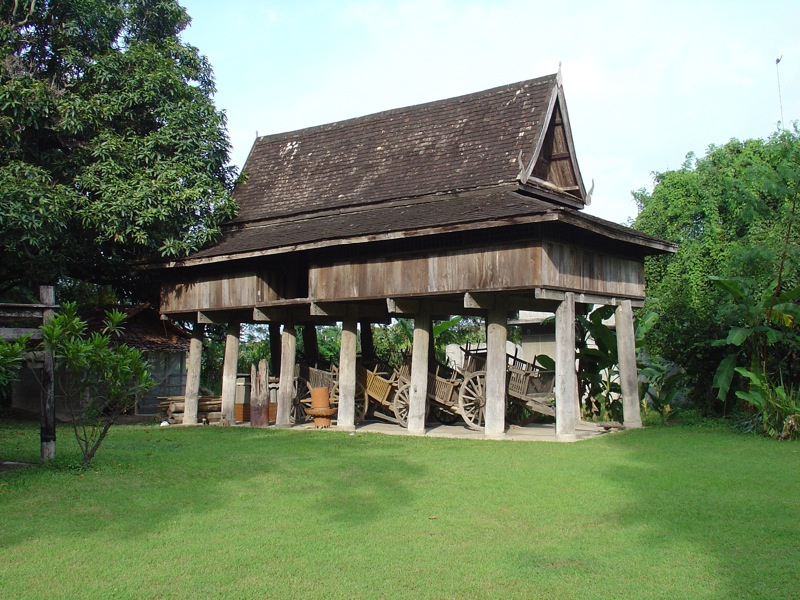 A fine rice house, used only for storage. The form is a lot like granaries from as far away as Portugal. There is a Lanna folk tradition, that as a boy went out to search for a girl to marry (Lanna culture is matrilineal, so the boy marries into the girl's family) he wanted to find a family with a rice house with more than six post (too few and he would starve, not enough rice), and less than fourteen (too many and he would have to work harder that a water buffalo). This one is on the large side.
A fine rice house, used only for storage. The form is a lot like granaries from as far away as Portugal. There is a Lanna folk tradition, that as a boy went out to search for a girl to marry (Lanna culture is matrilineal, so the boy marries into the girl's family) he wanted to find a family with a rice house with more than six post (too few and he would starve, not enough rice), and less than fourteen (too many and he would have to work harder that a water buffalo). This one is on the large side. Just a little gratuitous anthropophagy. Because nothing tastes quite like people.
Just a little gratuitous anthropophagy. Because nothing tastes quite like people.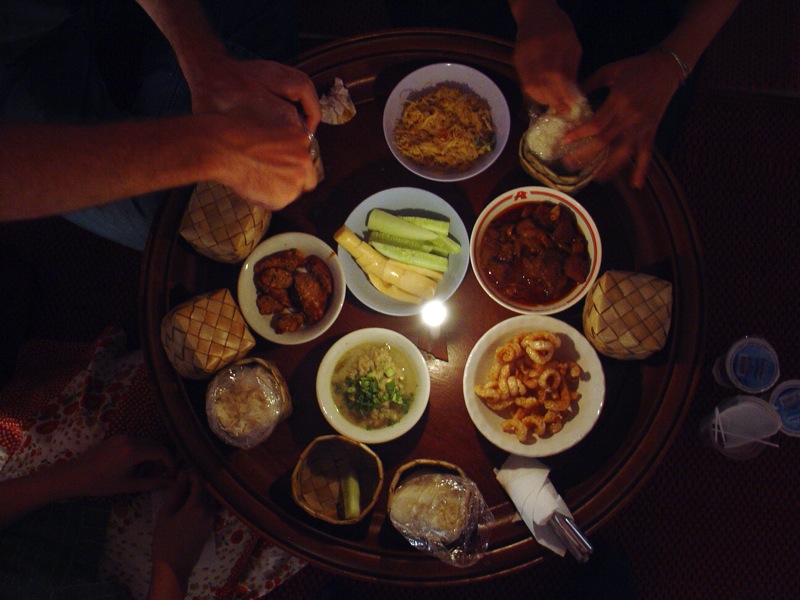 After a full day of lectures and touring we went to the Chiang Mai university campus for an evening of food, music and dance. Northern Thai food is a sight better than people, though I would have eaten that curry no matter what was in it. Maybe that's what the anthropophagi were making.
After a full day of lectures and touring we went to the Chiang Mai university campus for an evening of food, music and dance. Northern Thai food is a sight better than people, though I would have eaten that curry no matter what was in it. Maybe that's what the anthropophagi were making.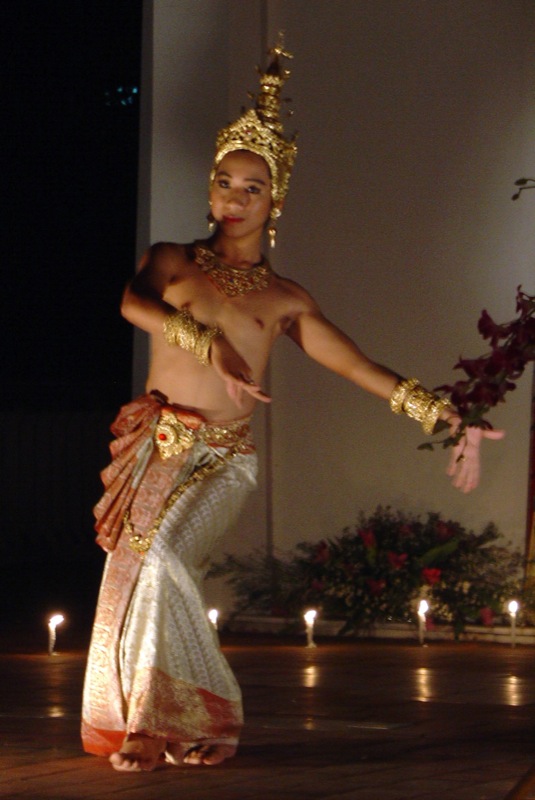 Nice hat?
Nice hat?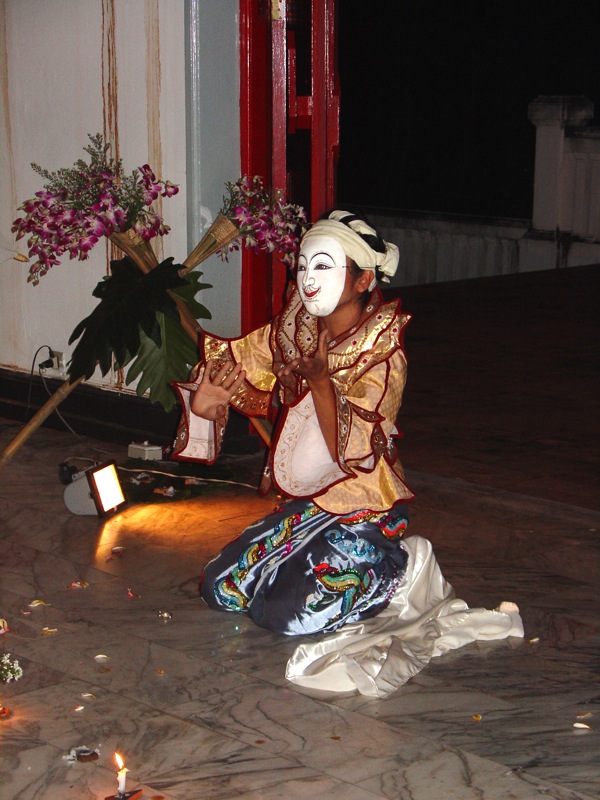 This mask dance was one of our favorites.
This mask dance was one of our favorites.We call this one, informally, the butterfly dance, though it could be of a bird or a bat. We don't know much about traditional Thai dance yet, but we have been told that the different hand positions have different meanings.
Day Two:
 Day two began early with a visit to a tiny little wat outside of Lampang, and it didn't end until about 16 hrs later. Wat Pongyangkok is about three hundred years old. Originally it stood on a platform one meter above the ground, but now it sits about eight inches below. It is unique in that it has retained its open-air form. Normally villagers "restore"their wats by putting brick and stucco walls between the outer posts, and then covering the thing with bits of colored mirror and sheets of gold colored flashing.
Day two began early with a visit to a tiny little wat outside of Lampang, and it didn't end until about 16 hrs later. Wat Pongyangkok is about three hundred years old. Originally it stood on a platform one meter above the ground, but now it sits about eight inches below. It is unique in that it has retained its open-air form. Normally villagers "restore"their wats by putting brick and stucco walls between the outer posts, and then covering the thing with bits of colored mirror and sheets of gold colored flashing.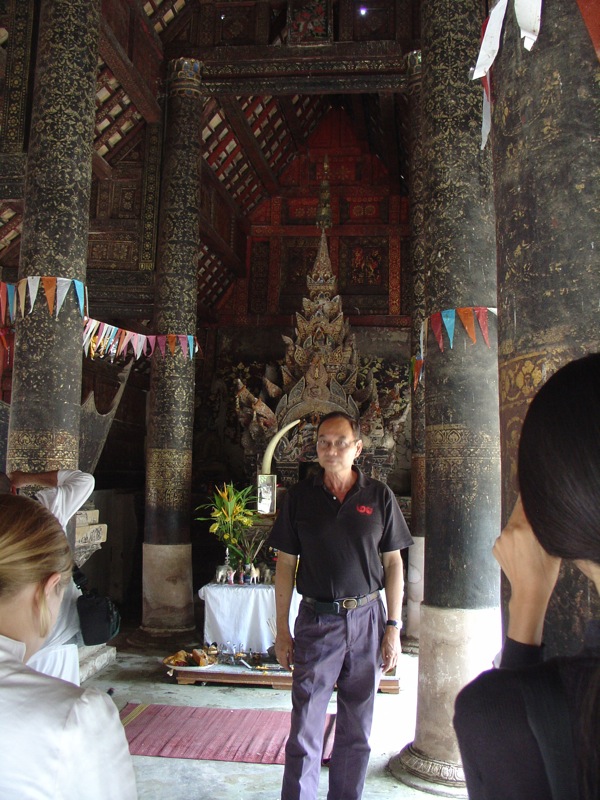 Vithi in the interior of Wat Pongyangkok. Also: the back of Jami's head, and the back of Nok's head.
Vithi in the interior of Wat Pongyangkok. Also: the back of Jami's head, and the back of Nok's head.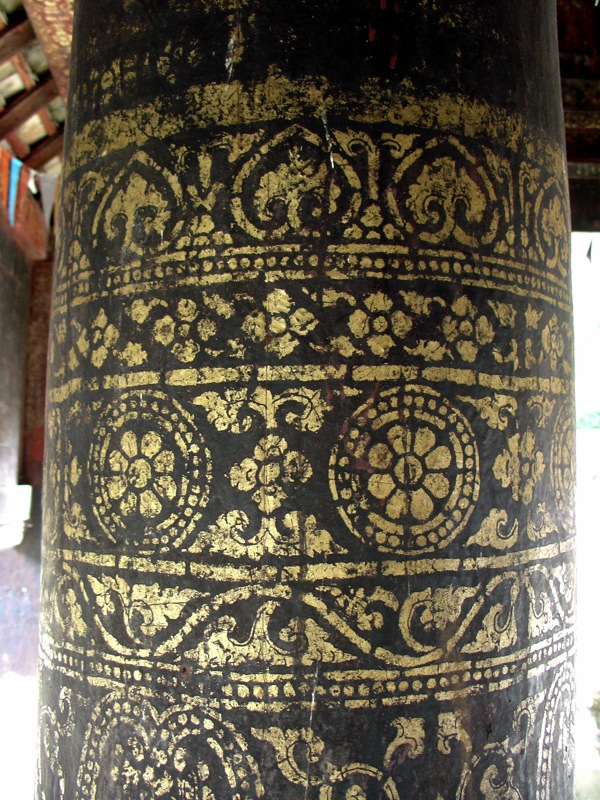 The pillars in Wat Pongyangkok were just amazing. They are covered with lacquer and goldleaf. On our Flickr page you can see how this is done, since they were the inspiration for one of my designs.
The pillars in Wat Pongyangkok were just amazing. They are covered with lacquer and goldleaf. On our Flickr page you can see how this is done, since they were the inspiration for one of my designs. Our next stop, and the last one I'll talk about in any detail, was Wat Phrathat Lampangluang in Lampang. It is an old citadel type wat, esablished 800 year ago, though its current incarnation is 15th century. In the photo you can see a tree inside the walls off to the left (not the palm tree). There is a legend that the Buddha passed through here on his travels. A Luah man (Austro-Asiatic ethnic group) offered him a piece of bamboo full of honey, and he was so happy having met the Buddha that he wandered off without his walking stick, leaving it stuck in the ground. When he came back the walking stick had sprouted, and grown into a tree. However, it had been put in the ground upside down, so the branches sloped downwards instead of up and the leaves were upside down. As legend has it that tree is here.
Our next stop, and the last one I'll talk about in any detail, was Wat Phrathat Lampangluang in Lampang. It is an old citadel type wat, esablished 800 year ago, though its current incarnation is 15th century. In the photo you can see a tree inside the walls off to the left (not the palm tree). There is a legend that the Buddha passed through here on his travels. A Luah man (Austro-Asiatic ethnic group) offered him a piece of bamboo full of honey, and he was so happy having met the Buddha that he wandered off without his walking stick, leaving it stuck in the ground. When he came back the walking stick had sprouted, and grown into a tree. However, it had been put in the ground upside down, so the branches sloped downwards instead of up and the leaves were upside down. As legend has it that tree is here. So how does a horse eat a Japanese Ceramicist? He sniffs along, sniffs along, takes a little bite. Sniffs along, sniffs along, takes a bigger bite. Sniffs along, sniffs along...
So how does a horse eat a Japanese Ceramicist? He sniffs along, sniffs along, takes a little bite. Sniffs along, sniffs along, takes a bigger bite. Sniffs along, sniffs along...Masamichi Yoshiakawa was one of the artists participating in this workshop (he and his wife Chikako). He thought it might be neat to pet this little pony, which promptly took a chunk out of his arm. In this photo here, you can see a blurry Masamichi with his sleeve rolled up to keep it out of the wound.
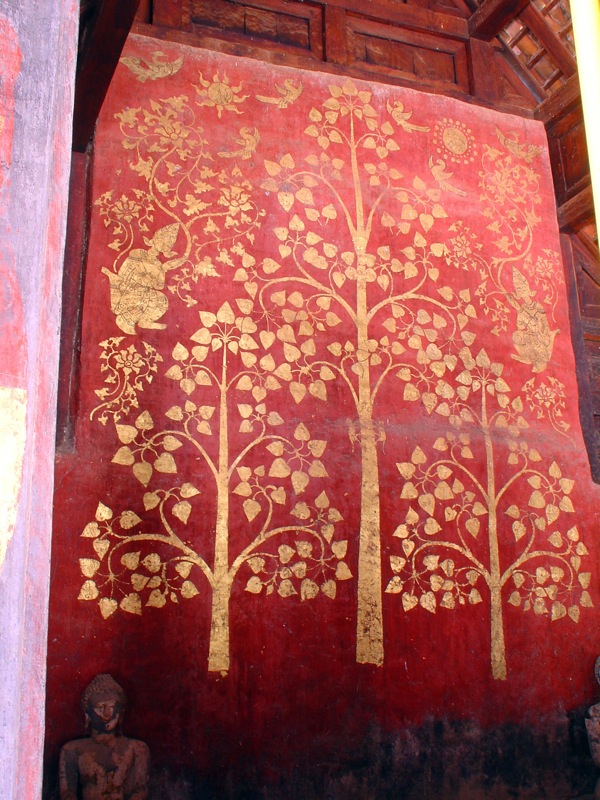 This was a particularly nice bodhi tree. These paintings typically back the Buddha images in the depths of the wat.
This was a particularly nice bodhi tree. These paintings typically back the Buddha images in the depths of the wat.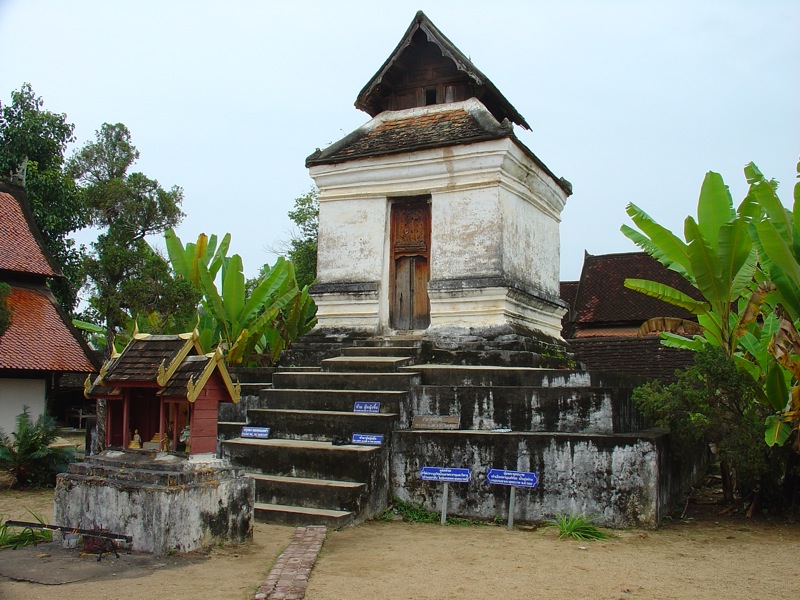 This little shrine at Wat Phrathat Lampangluang is covered with white on blue signs that say "NO GIRLS ALLOWED!"
This little shrine at Wat Phrathat Lampangluang is covered with white on blue signs that say "NO GIRLS ALLOWED!"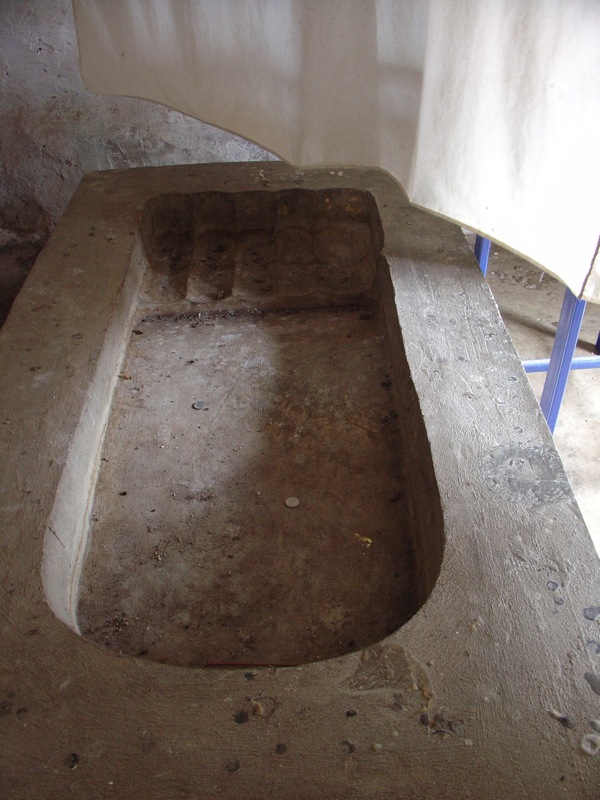 Inside is the footprint of the Buddha, who, even in life, had very large, stylized feet.
Inside is the footprint of the Buddha, who, even in life, had very large, stylized feet. The room also acts as a camera obscura, which allows you to see an image of this stuppa...
The room also acts as a camera obscura, which allows you to see an image of this stuppa...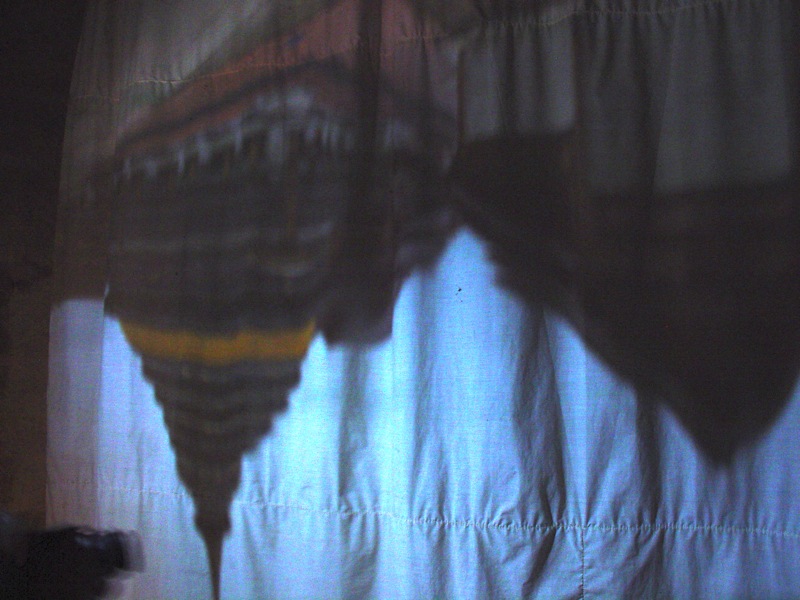 upside down.
upside down.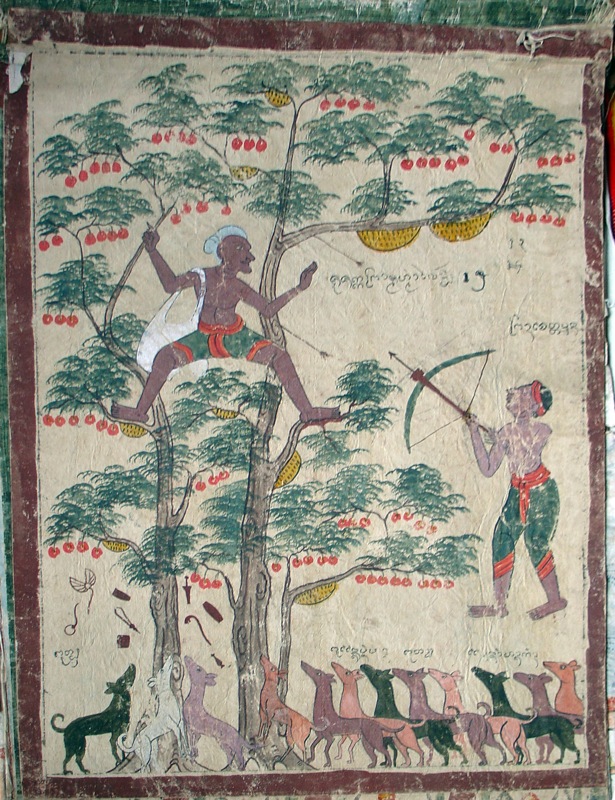 In the afternoon after lunch at Vithi's colonial era house in Lampang he took us to a wat where two large groups of hundred year old paintings had been discovered in the ceiling. This was one of my favorites, with the vagabond treed by a huge pack of dogs, and things dropping from his bag.
In the afternoon after lunch at Vithi's colonial era house in Lampang he took us to a wat where two large groups of hundred year old paintings had been discovered in the ceiling. This was one of my favorites, with the vagabond treed by a huge pack of dogs, and things dropping from his bag. The last wat we visited was fairly recent (about 100 years old), way out in the country and very, very folksy. Jami found this little guy holding up the pulpit, and he was just too cute not to share.
The last wat we visited was fairly recent (about 100 years old), way out in the country and very, very folksy. Jami found this little guy holding up the pulpit, and he was just too cute not to share.Days three through twelve:
These days include our trip to Maesai, Jami's indigo work shop at Studio Naenna (which she will write a post about, I already uploaded a video about it), and lots of work on our projects. We began the workshop not quite sure what we were supposed to be doing (the idea for my first project came suddenly as a complete image about ten minutes before I began talking to my assistant to tell him what materials I'd need), and it wasn't made clear to us that we actually needed to make two prototypes until Friday.
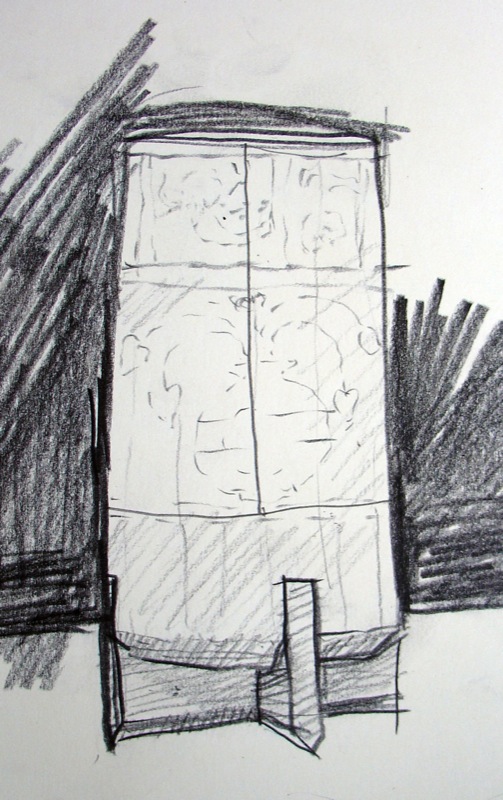 My original idea was to make a section of a column from a temple out of solid teak. A twenty four inch piece of solid teak, eight inches in diameter, proved to be hard to find, and would have been way heavy.
My original idea was to make a section of a column from a temple out of solid teak. A twenty four inch piece of solid teak, eight inches in diameter, proved to be hard to find, and would have been way heavy.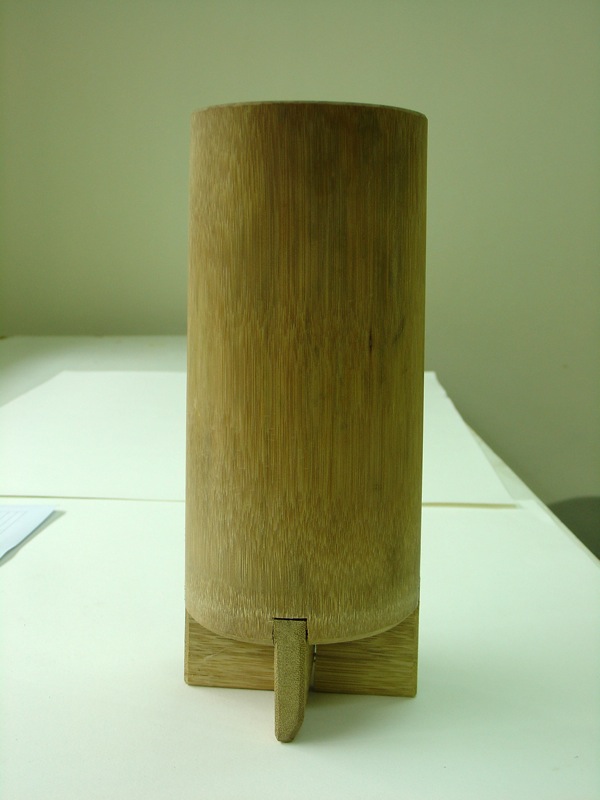 So I settled on bamboo, and turned it into a vessel. The base is inspired by the little feet on sticky rice baskets.
So I settled on bamboo, and turned it into a vessel. The base is inspired by the little feet on sticky rice baskets.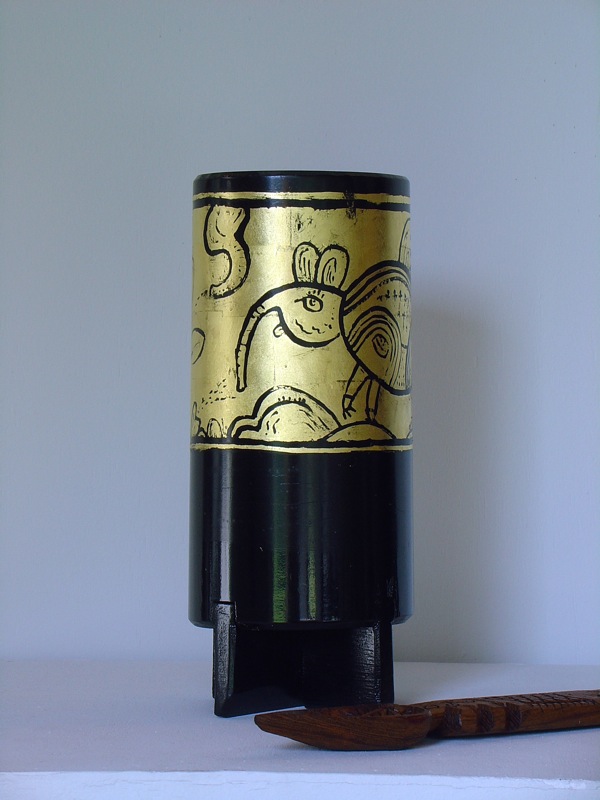 I think it turned out alright. I like the gold leaf on the black lacquer, but I kind of have a thing against precious materials, so I don't know if there will be a repeat (unless someone pays me to it). The part of the wat occupied by the pillars represents the Cosmic Jungle in the Theravada Buddhist cosmology. In our own American secular spiritual tradition (if that's not an oxymoron), i.e. Transcendentalism, we go to the woods to gain enlightenment (or at least you do if you are a genteel resident of Concord, Mass and have the luxury of romanticizing nature). In Therevada Buddhism you have to pass through the woods, then traverse seven rings of mountains, and then climb an even bigger mountain, only to find Siddhartha Gautama already sitting there. So I decided that it would be nice to package a piece of the Cosmic Jungle for export to the west.
I think it turned out alright. I like the gold leaf on the black lacquer, but I kind of have a thing against precious materials, so I don't know if there will be a repeat (unless someone pays me to it). The part of the wat occupied by the pillars represents the Cosmic Jungle in the Theravada Buddhist cosmology. In our own American secular spiritual tradition (if that's not an oxymoron), i.e. Transcendentalism, we go to the woods to gain enlightenment (or at least you do if you are a genteel resident of Concord, Mass and have the luxury of romanticizing nature). In Therevada Buddhism you have to pass through the woods, then traverse seven rings of mountains, and then climb an even bigger mountain, only to find Siddhartha Gautama already sitting there. So I decided that it would be nice to package a piece of the Cosmic Jungle for export to the west.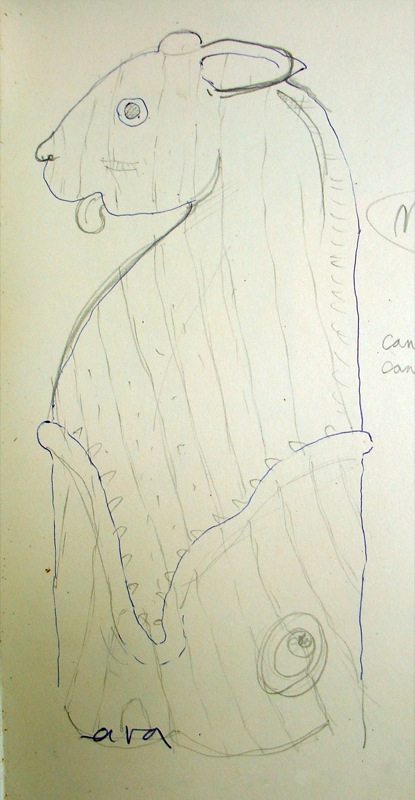 The naga love spoon went through many stages of revision. I even had a completely different piece roughed out before I decided that I hated it (our friend LB might recognize the remains of her name and email address which I erased from the bottom of this drawing. No spam for her).
The naga love spoon went through many stages of revision. I even had a completely different piece roughed out before I decided that I hated it (our friend LB might recognize the remains of her name and email address which I erased from the bottom of this drawing. No spam for her).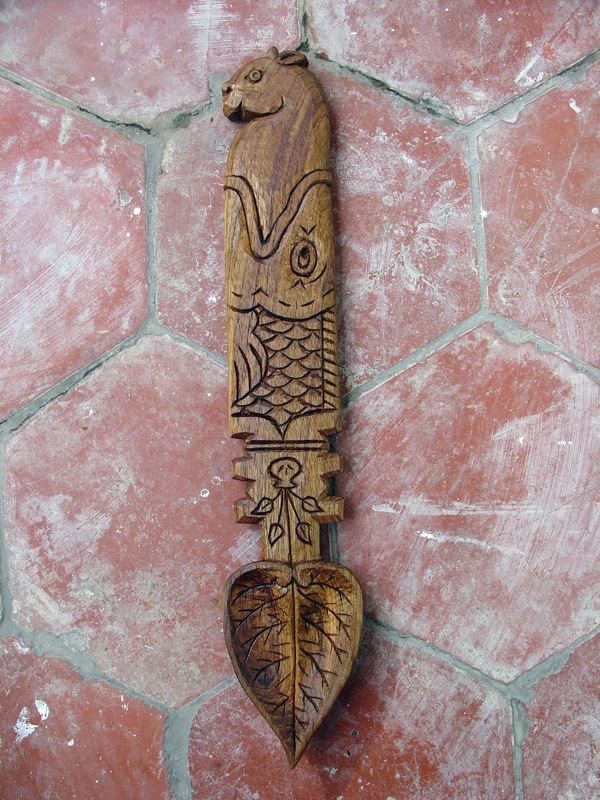 The overwhelming response from the Thai regarding this spoon was, "so cute!" the leaf forming the bowl is, of course, a bodhi leaf.
The overwhelming response from the Thai regarding this spoon was, "so cute!" the leaf forming the bowl is, of course, a bodhi leaf.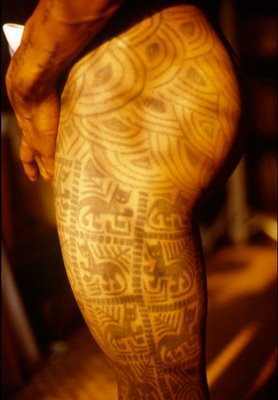 Jami's project involved tattooing male cabaret dancers.
Jami's project involved tattooing male cabaret dancers.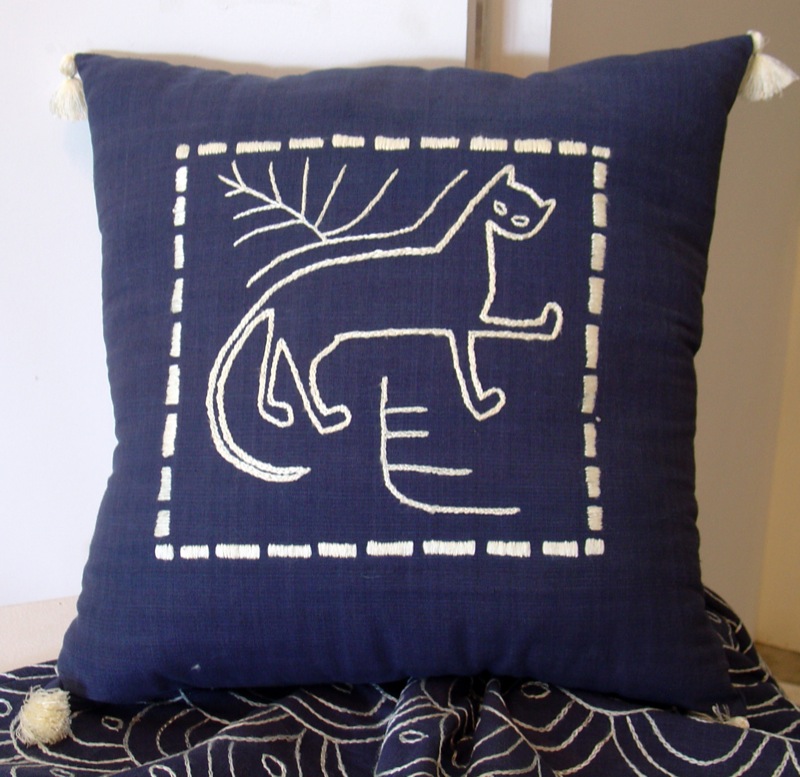 Just kidding. Those are actually traditional leg tattoos worn by Northern Thai men well into the twentieth century. Since boys usually got kicked out of the bedroom out onto the porch to sleep with grandpa around the age of nine, many, as they do today, ended up becoming novitiates at a local wat. Those that decided the life of celibacy was not for them left during their teens and joined a trade caravan, and went looking for a reasonably sized rice house. The leg tattoos were their cultural currency: the fish scale patterns endeared them to potential mother-in-laws on the northern routes up into China, while the cats worked in the southwest and out to the coast, where boats came from Sri Lanka.
Just kidding. Those are actually traditional leg tattoos worn by Northern Thai men well into the twentieth century. Since boys usually got kicked out of the bedroom out onto the porch to sleep with grandpa around the age of nine, many, as they do today, ended up becoming novitiates at a local wat. Those that decided the life of celibacy was not for them left during their teens and joined a trade caravan, and went looking for a reasonably sized rice house. The leg tattoos were their cultural currency: the fish scale patterns endeared them to potential mother-in-laws on the northern routes up into China, while the cats worked in the southwest and out to the coast, where boats came from Sri Lanka.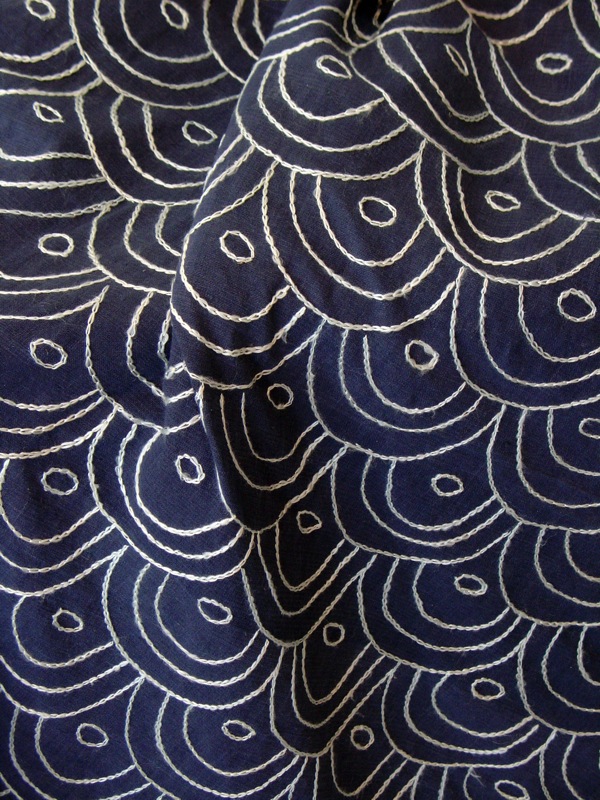 A dedicated team of women from a crafts circle somewhere outside of Chiang Mai helped finish all these fish scales in time.
A dedicated team of women from a crafts circle somewhere outside of Chiang Mai helped finish all these fish scales in time.Day Thirteen:
In the morning all the participants gave brief presentations of their projects and prior work. The westerners went last. I wish everyone had a website for me to refer you to, but the only ones that do are Dave Besseling and Ofer Zick (though if anyone knows of any more I'll happily take corrections). For dinner we headed to a fancy open air restaurant that specializes in Lanna cuisine. And then the fun began.
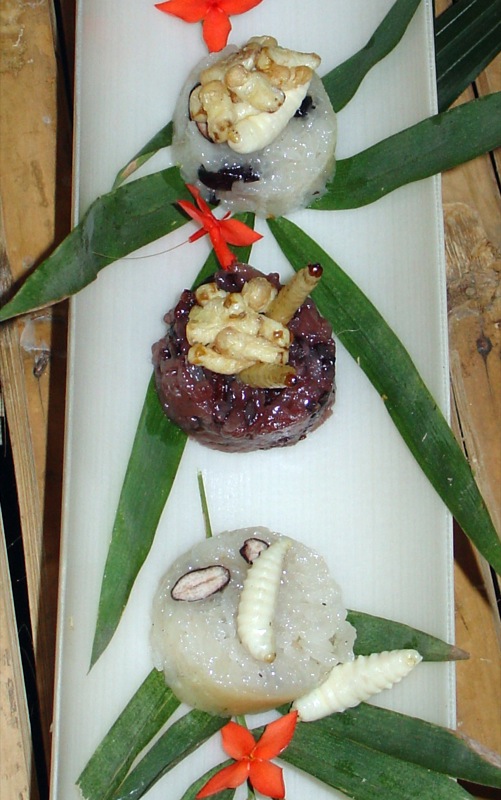 Yes these are what you think they are. Bug hors d'oeuvres. I ate the one on the bottom. It popped, and left a weird film on my teeth, but it tasted OK. To our surprise, no amount of teasing from Ofer and Dave could get the Thai art and design students to try one. Instead they burnt their's to crisps in the candles.
Yes these are what you think they are. Bug hors d'oeuvres. I ate the one on the bottom. It popped, and left a weird film on my teeth, but it tasted OK. To our surprise, no amount of teasing from Ofer and Dave could get the Thai art and design students to try one. Instead they burnt their's to crisps in the candles.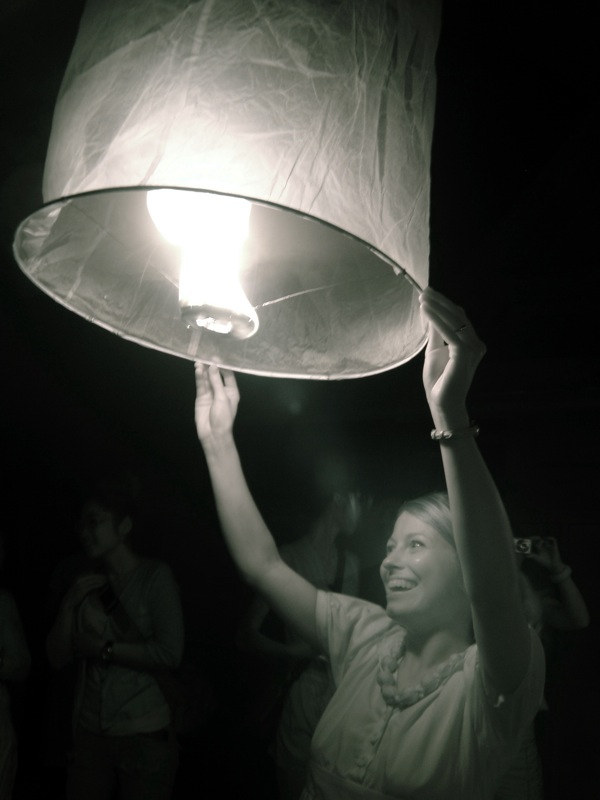 The highlight of the evening was setting off hot air balloons over the pond.
The highlight of the evening was setting off hot air balloons over the pond.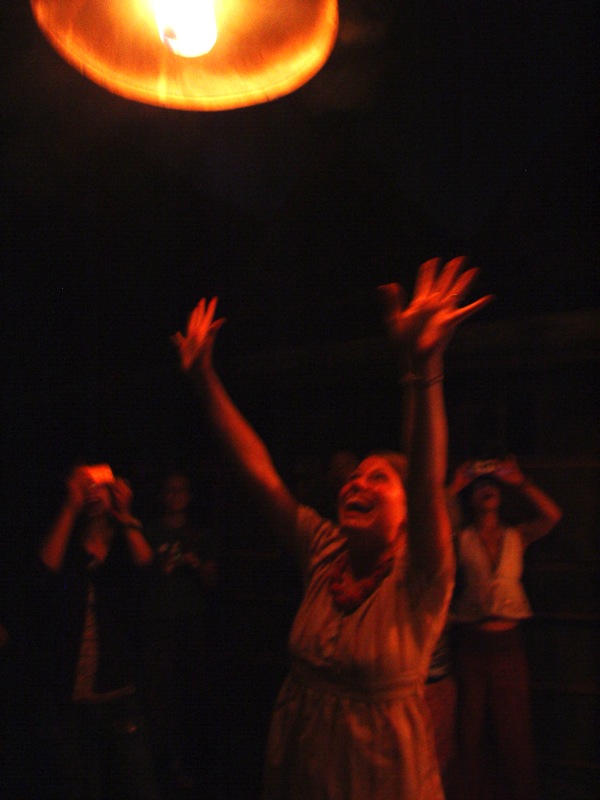 A couple got caught in a tree, but thankfully they worked their way out before catching anything on fire.
A couple got caught in a tree, but thankfully they worked their way out before catching anything on fire.These lovely ladies (oops, laddies i mean) were probably a close second or third after the balloons and bugs. It kind of surprised us how common transvestitism is here in Thailand, but it has none of the stigma associated with it in the states. There's matriarchy for you. Everybody just gets along.
